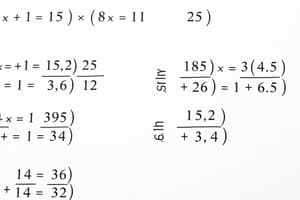Podcast
Questions and Answers
What are the steps to multiply the polynomials?
What are the steps to multiply the polynomials?
- Distribute (correct)
- Combine like terms (correct)
- Multiply the coefficients
- Add the exponents
What are the steps to factor completely given one factor?
What are the steps to factor completely given one factor?
- Apply the quadratic formula
- Rewrite using binomials
- Factor the result (correct)
- Divide the polynomial (correct)
What are the steps to factor completely?
What are the steps to factor completely?
- What two numbers multiply to A*C that adds to B? 2. Split up the middle term using the two numbers. 3. Group; pull out a common factor from each group. 4. If the two leftover terms match, pull it out and pull down what's left.
You can use the difference of squares if there are only two terms, both perfect squares, and a subtraction sign.
You can use the difference of squares if there are only two terms, both perfect squares, and a subtraction sign.
What is the formula for factoring a difference of squares?
What is the formula for factoring a difference of squares?
What are the steps to factor completely when there are four terms?
What are the steps to factor completely when there are four terms?
How do you factor completely multiple polynomials?
How do you factor completely multiple polynomials?
What are the steps to divide a polynomial?
What are the steps to divide a polynomial?
How do you find the zeroes of a polynomial?
How do you find the zeroes of a polynomial?
What is the procedure when factoring with $x^4$?
What is the procedure when factoring with $x^4$?
Flashcards are hidden until you start studying
Study Notes
Multiplying Polynomials
- Distribute each term in the first polynomial across all terms in the second polynomial.
- Combine like terms after distribution to simplify the expression.
Factoring Polynomials
- Given one factor, divide the polynomial by this factor to find the result.
- Further factor any remaining polynomial completely.
Complete Factorization Steps
- Identify two numbers that multiply to ( A \cdot C ) (product of leading coefficient and constant) and add to ( B ) (middle term).
- Split the middle term using these two numbers to facilitate grouping.
- Group terms into pairs and factor out common factors from each group.
- If the remaining terms are identical, factor them out as well.
Difference of Squares
- Applicable when there are only two terms that are perfect squares and a subtraction sign present (e.g. ( a^2 - b^2 )).
- Recognize this as a specific case for simple factoring.
Factoring Difference of Squares
- Take the square roots of both terms:
- The first term’s square root and the second term’s square root.
- The expression factors as ( (\text{square root of } a + \text{square root of } b)(\text{square root of } a - \text{square root of } b) ).
Factoring Polynomials with Four Terms
- Divide the polynomial into two groups of two terms each.
- Factor out common factors from each group.
- If the leftover terms are the same, factor them out and simplify further.
- Check if any group can be factored using the difference of squares method.
Handling Multiple Polynomials
- Maintain a separate factoring process for each polynomial in a sum or difference.
- Factor each polynomial individually to achieve full factorization.
Polynomial Division
- Write the polynomial equation ensuring each power of ( x ) is represented, inserting zeros where necessary.
- Divide the leading term of the dividend by the leading term of the divisor.
- Multiply the divisor by this term and subtract from the dividend.
- Repeat the process until all terms are accounted for, ending with a possible remainder.
Finding Zeros of a Polynomial
- Rearrange the polynomial to set it equal to zero.
- Factor the polynomial and set each factor equal to zero to find solutions.
- Solve each equation by adding or subtracting constants and dividing or multiplying coefficients as needed.
Factoring with Higher Powers
- Treat ( x^4 ) as if it were ( x^2 ) for simplification.
- Follow standard factoring procedures, translating the higher-degree polynomial into manageable components.
Studying That Suits You
Use AI to generate personalized quizzes and flashcards to suit your learning preferences.




